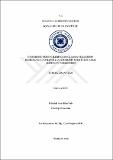Please use this identifier to cite or link to this item:
http://hdl.handle.net/11547/2399| Title: | ÜNİVERSİTE ÖĞRENCİLERİNDE BAĞLANMA STİLLERİNİN DAMGALAMA DAVRANIŞIYLA İLİŞKİSİNİN ÖFKE İFADE TARZI AÇISINDAN İNCELENMESİ |
| Authors: | Aydın, Merve |
| Keywords: | Attachment Stigmatization Anger Bağlanma Damgalama Öfke |
| Issue Date: | 2018 |
| Publisher: | İSTANBUL AYDIN ÜNİVERSİTESİ SOSYAL BİLİMLER ENSTİTÜSÜ |
| Abstract: | In this study, it is aimed to examine the relation of attachment styles in college students with stigmatization behavior in terms of anger expression style. The research sample consists of 360 volunteering students in 6 different departments (Sociology, Turkish Language Teaching, Primary School Teaching, Industrial Engineering, Software Engineering, Political Science and International Relations) of the Faculty of Science and Letters, the Faculty of Education, the Faculty of Engineering, and the Faculty of Economics and Administrative Sciences at Istanbul Aydın University. Stratified Sampling Method was used in creating the study’s universe. Personal Information Form, Experiences in Close Relationships Scale II, Stigma Scale, Trait Anger and Anger Expression Scale were used as data collection tools. Data were evaluated on the SPSS program using independent sample t-test, ANOVA, and regression analysis. The statistical analysis results of the data can be summarized as follows: It has been found that women have more avoidant attachment scores than men. It was found that Anger-In subscale, gender makes a significant difference. It has been found that men have higher anger-in scores than women. In the Labeling, Discrimination and Exclusion subscale, gender shows a significant difference. It has been found that men have higher labeling, discriminatory and exclusionary scores scales than women. It has been found that participants' ages differ significantly in the anxious attachment subscale. It has been found that those in the 18-age group have higher anxious attachment scores than those in the 20-age group. It has been found that the association status of the participants’ parents significantly differs in the avoidant attachment subscale. It has also been found that, contrary to what is expected, participants whose parents are alive and live together have higher avoidant attachment scores than those with parents who are alive and separated. According to those who had been obliged to take responsibility at an early age, have higher scores for SL-Anger and Trait Anger, and that this difference significantly differentiated the two groups. It has been found that those who have experienced any type of violence in the past have higher Anxious Attachment and Trait Anger than those who have not been victims of violence, and this difference significantly differentiates the two groups. Another surprising finding is that those who responded because of their sexual identity have a higher Discrimination-Exclusion than those who did not, and this difference significantly differentiated the two groups. There are also four variables to predict Trait Anger in the study. The strongest predictor variables are anger-out, maternal education level, anger-in and anger control respectively. The most important variables which determine Anger-In are anxious attachment, trait anger, reaction to sexual identity, sudden loss and outward reflection of the anger. The most important variables which predict Anger-Out are low family income, trait anger, anger-in and low anger control. The most important variables that predict anger control are the low level of trait anger and anger-out. |
| URI: | http://hdl.handle.net/11547/2399 |
| Appears in Collections: | Tezler -- Thesis |
Files in This Item:
| File | Description | Size | Format | |
|---|---|---|---|---|
| 516677.pdf | 2.76 MB | Adobe PDF |  View/Open |
Items in DSpace are protected by copyright, with all rights reserved, unless otherwise indicated.
